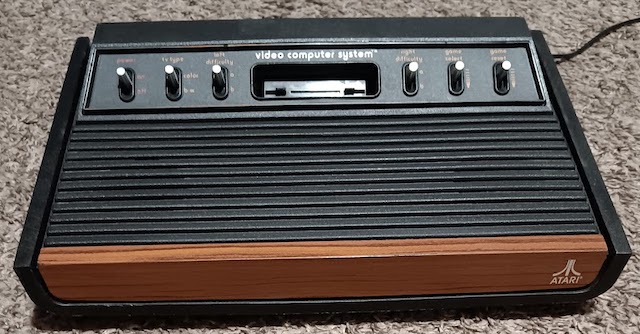

| PLUS PROBLEMS The Noise Problem with the Heavy/Light Sixer Atari vCS/2600 and the new Plus series Wireless COntrollers |
  In 2024 Atari released new controllers compatible with their new 7800+ and 2600+, as well as reverse compatible with their previous systems, or anything that runs the Atari standard controller pinout (ie Commodore 64 computers, Atari 400/800/1200-series, Words+ AAC units...hehe). Anyway, of course a lot of us bought them....except there's one problem with them....eh....see below....
In 2024 Atari released new controllers compatible with their new 7800+ and 2600+, as well as reverse compatible with their previous systems, or anything that runs the Atari standard controller pinout (ie Commodore 64 computers, Atari 400/800/1200-series, Words+ AAC units...hehe). Anyway, of course a lot of us bought them....except there's one problem with them....eh....see below....

Above are my two VCS units, a 1978 Taiwanese "Heavy Sixer" and a 1980 Hong Kong Sears "Light Sixer". As discussed in the Tech Page - there's some moderate to drastic circuitry differences between these early units and the later "4-switch" and "Junior" consoles. See, the issue we're all seeing, is quasi-musical "noise" when the controller starts talking to the dongle. So this page is going to act as sort of a collection of data on this minor inconvenience, since I'm collecting a lot of data both of my own, and from the AtariAge forums. And, just because I'm a technie guy, so this kind of stuff intrigues me. First, a side note about Heavy Sixers - most, not all, but most Atari Video Computer System "Heavy Sixers" will have problems with the dongle fitting. This is because of the back plastic trim on the console blocking the dongle from being fully inserted. My theory as to why it's only SOME that have the issue, is because of differences between production parts used for the controller ports across the 200,000 or so of these consoles that were built. The first lots were made in Sunnyvale California, and might have a longer-extended port that will allow the wireless controllers to be used. In 1978, production of the "HEavy Sixer" was moved to Taiwan (and overlaps with the Sunnyvales a little), and these seems to be more consistant as they use parts found in a Light Sixer, which the ports are shorter and don't hold the dongle as well, if at all. The fix for this issue is to use an extension cable.... The reason this is important is because, at some point, I might be considering leveraging this issue to fix the other, main problem. If we can find a way to resolve it using external electronics. The main problem is that when the controller and the dongle sync and activity begins, a semi-musical, changing tone is heard through the TV, and sometimes even "interference" is seen on screen (albiet very minor in my cases). You can hear this in a bunch of early youtube videos from 2025 as I'm using my Sears Telegames LIght Sixer with the wireless controller. What we know about the Sixer Consoles Electronically The primary electronic difference between a "Sixer" and any other VCS/TeleGames, is the CD4050 hex chip used to "Debounce" the fire button lines, and provide some amplification for the video signal. This difference is why the Sixers are a very popular choice for purchasing an original Atari console, because the CD4050 tends to enhance and make the colors "richer". There's more to it than "it's the original" as to why people like those Heavy Sixers so much. What we know is the Atari dongle is the only one that seems to pick up racket. A post at AtariAge (ignore that it devolved into a bunch of teenager level bullying b.s.) discusses that a constant 5v signal is being allowed across data lines. This has me thinking of a few things. First off, we may be able to can the noise using Diodes. I've done this in guitar circuits, so there's no reason this wouldn't work. List of things tried at AtariAge Study of the Schematic (and my thoughts) My "experiments" My "Dongle" Extender Idea The idea is to create a DB-9 Female to Male unit with minimal circuitry within to minimize, if not fully eliminate, the noises made by the Atari CX-40+ and CX-78+ wireless dongles. This will be achieved by breadboarding a circuit that removes the noise but doesn't affect the Atari's ability to be controlled in any way. The way it would be made is I will take two connectors, solder up the circuit, do straight through for the rest of the plug, and then fill the gaps with hot glue, and then wrap in a heat-shrink tubing. This should make a nice, solid, dongle. I'm toying with an idea of making it right-angle too so you could see the Wireless status over the top of the "Sixer" by having the dongle stick up from in back enough to show the LED. |